

  |
|
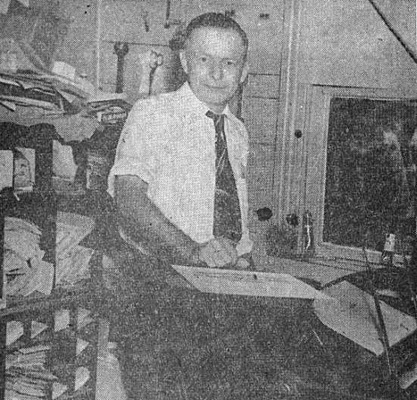
|
Name: Robert Lee Bryan Scottsville Printer and Newspaper Man Date: June 1952 Image Number: Scottsville Sun, June 1952 Comments: Robert Lee Bryan was born on 21 January 1909 in Charlottesville, VA, and was the son of William Whitaker Bryan (1880-1930) and Addye (Beattie) Bryan (1886-1955). William Bryan ran a print shop called the Virginia Printing Company, and his son, Robert, started helping his father by running printing errands for him when he was only five years old. Robert learning the printing trade from his father while attending public school in Charlottesville. After his father passed away in 1930, Robert carried on the family's printing business for several years before coming to Scottsville. Robert married Marie Irene Hamilton (1918-2013) in Scottsville, VA, on January 11, 1944. Robert and Marie were the parents of two daughters, Mildred Lee Bryan and Nancy Carolyn Bryan. Robert passed away on April 29, 1953, in Charlottesville, VA. To learn more about Robert Bryan's career as a printer and editor of two Scottsville newspapers, read the following article by Elizabeth Wimer which was published in the Scottsville Sun on June 5, 1952: Bob Bryan, Learned Printing Trade From His Father; Had Tough Job With Weekly By Elizabeth Wimer Scottsville Sun, Thursday, June 5, 1952, Scottsville, VA There has always been an atmosphere of adventure about the printing business, and with the ups and downs which it entails, one is almost sure to find a printer a most entertaining sort to chat with. Bob Bryan of Scottsville is no exception. When he is not printing, he most often is talking to someone, and has a keen interest in all that goes on in the community. Bob, (he was christened Robert Lee Bryan), is also an ex-newspaper man, having been a "jack-of-all-trades" on the Scottsville News from 1938 to 1944. He also set type for the Aulander, N.C., Advance from 1925 to 1927. This probably accounts for the fact that he is not used to keeping regular hours, and has been known to run off a job in the middle of the night to accommodate a person who has to have it done by morning, and he once got out of bed with high fever to do a printing job for a lady who had traveled from another town to bring it to him. Bob was born in Charlottesville, the son of Mr. and Mrs. W.W. Bryan. He was practically born in a print shop, he says, starting to help his father by running errands in his shop, the Virginia Printing Company, when he was five years old. He attended public school in Charlottesville, learned the printing trade from his father and worked first in Aulander, N.C., and at the University of Virginia. After his father's death in 1930, Bob carried on the family business in Charlottesville for two or three years before he came to Scottsville. During this time, he also entered the weatherstripping business on the side, and he frequently takes on a job of weatherstripping when the printing business slows up. The toughest job he ever tackled, he said, was getting out the Scottsville News, a weekly paper, during a week when there was zero weather, snow and ice, and the mail could not get through. No news or advertising was sent in, and since it was practically impossible to get around, and print the paper, too, he managed to put it out all by himself while a helper stoked the stove to keep the ink from freezing. He recalls that the only fresh news he had out of Scottsville that week was that a colored man froze to death and he managed to stretch it out to a two-column article. Now Bob has his own shop in the basement of his home on Harrison Street, and prints just about everything except a newspaper. He hopes to put in more equipment, he said. His customers are not only local, but he does work for people as far as Washington, D.C., as well as in Richmond and Charlottesville. Bob is a member of the Scottsville Lions Club, the Scottsville Volunteer Fire Department, and the Monticello Guard Veterans Association which he helped to organize. A favorite and productive pastime for Bob in the spring and summer is the Bryan vegetable garden. "I like to get my butter beans fresh and clean from the garden," Bob said. "You don't get them the same way in the grocery store. He also raises tomatoes, snap beans, and other vegetables. Mrs. Bryan is the former Miss Marie Hamilton of Charlottesville. The Bryans have two little girls, daughters Mildred Lee and Nancy Carolyn Bryan. Im 2021, Ranny Moulton told us that the June 1952 photo (shown above) in the Scottsville News shows "Bob Bryan, who was the operations man (type setter, Linotype operator, press operator, and more) for the Scottsville News. Kay Langhorne was the editor. My job around 1940 was paper cutter and folder when double sheets came off the press. Bob would take a shot of Vodka and go to work on the paper." In 2018, Millie Bryan, daughter of Robert and Marie (Hamilton) Bryan, authored a interesting article entitled, "My Scottsville Childhood," which tells more about the Bryan family's life in Scottsville beginning in 1942 and how her father ran his print shop in town after new owners took over production of the Scottsville News. To learn more, read this excerpt from Millie's article, which appeared in the June 20, 2018 edition of the Scottsville Monthly: My Scottsville Childhood by Millie Bryan Scottsville Monthly,July 20 - August 15, 2018, Palmyra, VA I count myself fortunate indeed to have had a Scottsville childhood. Especially one in the 1940's and early '50's when many of the pleasant ways of an earlier Scottsville still lingered. When I arrived in town as a week-old baby in August, 1942, Scottsville, like the rest of the country, and most of the world, was at war. As it had in previous wars, Scottsville did its part. By late summer, most young men were in some branch of the armed services. From time to time, troop trains sped past the little gray depot down by the river, cars packed with uniformed men on the first part of a journey that would eventually take them to battlefields in Europe and the Pacific. On the home front, rationing was in full force. My very first memory of the war is of rationing books filled with tiny stamps, printed in brown ink on tan paper, allowing the bearer to buy specified quantities of meat, sugar, coffee, and other foods. As I was writing this, I happened upon a photograph of a World War II ration book. It looked exactly as I had remembered it. 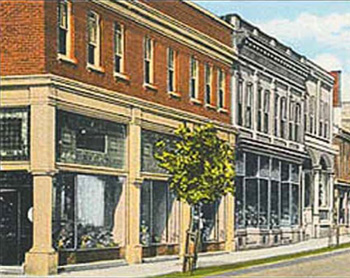 Certain materials were just unobtainable. The last Christmas of the war, I asked Santa for a tricycle. My father explained that
tricycles were made of metal and rubber that were needed to make ships, planes, and other things for the war and I would have to wait until
after the war was over to get my tricycle. After the war, I got it, a red one with black rubber grips on the handlebars, and I pedaled
happily up and down the tree-lined street that ran past the apartments over what was then Bruce's Drugstore (shown above) on Valley
Street. We lived in the little apartment on the far left as you look toward Valley Street. Certain materials were just unobtainable. The last Christmas of the war, I asked Santa for a tricycle. My father explained that
tricycles were made of metal and rubber that were needed to make ships, planes, and other things for the war and I would have to wait until
after the war was over to get my tricycle. After the war, I got it, a red one with black rubber grips on the handlebars, and I pedaled
happily up and down the tree-lined street that ran past the apartments over what was then Bruce's Drugstore (shown above) on Valley
Street. We lived in the little apartment on the far left as you look toward Valley Street.The locust trees that bordered the sidewalk are gone now. The yard, the grass greener and thicker, is now Dorrier Park. Bruce's Drugstore is now the Riverbend Day Spa. But our old apartment is still there. During the earlier years of the war, my father, Robert Bryan, was the editor of The Scottsville News. How well I remember his pale, drawn face when he came home at lunchtime from the newspaper one day to tell my mother that a Scottsville boy had been killed in the war. Always a close-knit community, Scottsville was even more so during the war. When a son of Scottsville died, the entire town mourned. Sometime to my great delight, my father took me to the newspaper office with him. The Scottsville News was housed in the nineteenth-century tavern that still stands at the end of East Main Street. Now an apartment, it still looks much as it did more than seventy years ago when I first stepped into the big front room with its antique (even then) printing press and type cases full of lead type. 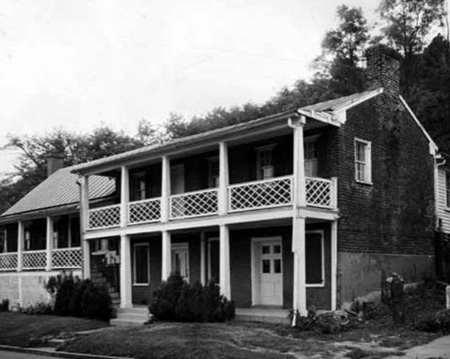 Millie Bryan's father was editor of the Scottsville News which was housed in the 19th-century tavern that still stands as an apartment house today at the end of Scottsville's Main Street. At a very early age, I learned to use the telephone to call my father at work. Remembering the number was easy. Scottsville phone numbers in those days were two digits. You told the operator the number, and she connected you. Perhaps it was because my father was a newspaperman that some of my most distinct memories of my childhood have to do with some form of communication. I can still see my father, my mother and I clustered around our table-top cathedral radio listening to the latest news of the war. Invariably, my father would say to me, as he clicked on the radio, "Listen to this. Someday you will want to remember it." Proud to be included in such grown-up activity, I pushed my little red rocking chair in front of the radio and sat down to listen to reports of far away battles and horrors I only partly understood. When I began thinking about writing this memoir, I asked my mother if she remembered when the three of us used to listen to the radio during the second world war. Ninety-four and nearly blind, she looked vacantly off into the distance. I wasn't sure she had heard me, or, if she had, would be able to respond. Her answer, after a few seconds, was succinct and starkly eloquent. "This is London," she intoned, for a moment, and was silent again. Then she said, "Mr. Murrow." My mother had just recited the signature opening line of the broadcasts of Edward R. Murrow, for many Americans, the voice of Britain during World War II. After new owners took over the production of the Scottsville News, my father opened a print shop in an old white frame building, just off East Main Street, near the train depot. I believe the building is still there. In his print shop, my father printed handbills, letterhead, church bulletins, and other small jobs. Like all printers, he bought quantities of large sheets of paper, then cut them to size on a powerful paper cutter. As the knife sliced through the paper, it discharged a cascade of paper that was mine to use as I pleased. My endless supply of paper was the envy of all my friends. In my childhood, the material we used for arts and crafts (We didn't call it that then.) were basic at best. Beyond what paper we could scavenge, we had coloring books, crayons, tins of watercolor paints, and rubber-capped bottles of mucilage bought at Mathias's Dime Store on Valley Street. With these simple materials, we were expected to entertain ourselves. Children complaining of boredom were told by exasperated adults, "Color a picture." Or "Make something." One of the greatest pleasures of my childhood was the occasional train trip to Richmond when my father went there to buy paper for his print shop. The train to Richmond still stopped in Scottsville then. After my father bought our tickets, we waited inside the station for the train to arrive. Soon we heard a faint rumbling as the train rounded the Horseshoe Bend. Vibrations rippled through the station, I ran out onto the platform to watch the train come to a stop, stream swirling, air brakes hissing. We quickly got settled in our seats, and the train began to move. Soon we were rolling down the tracks alongside the James River, tracks that had been built on the towpath of the historic Kanawha Canal. Once we were under way, I indulged in my favorite on-train pastime. Fascinated by the water fountain built into the front end of the car, I took one of the cone-shaped paper cups provided and helped myself to a drink of water. During our one-hour ride, I must have made at least five visits to the water fountain. When we arrived in Richmond, the engineer began expertly backing the train over a narrow trestle that spanned the James River, I stood at the window, staring down at the muddy water. The least bit off track and the train would topple into the river. I was always greatly relieved when the train pulled safely into the old Broad Street Station. After the war, the wave of prosperity that swept over most of the country, trickled into Scottsville. Several new businesses came to town. Life moved at a slightly faster pace, but Scottsville was still that unique little town on the James River that it had always been. One of the biggest events of the post-war period for me was the birth of my sister, Nancy, in December 1946. While my mother was in the Martha Jefferson Hospital, I stayed with my grandmother in Charlottesville. When my mother and newborn sister were discharged from the hospital, I rode back to Scottsville with them, sitting on the jump seat of a Thacker Brothers ambulance. The year I was ten years old was my last year in Scottsville. My memories of that year are a bit jumbled. By that time, I was aware that my father was seriously ill. I remember that during the summer or around the beginning of September, someone organized a Girl Scout troop which I joined. We met at the Episcopal Church, the white frame church at the foot of the hill on Harrison Street. I remember my father taking me to C.R. Dorrier's dry goods store to buy brown oxfords to wear with my Girl Scout uniform. An old-fashioned store, with dark wood counters and shelves. It was infused with the scent of leather, wool, and new cotton cloth. Mr. Dorrier's store was in the building that is now 'The Tavern on the James.' 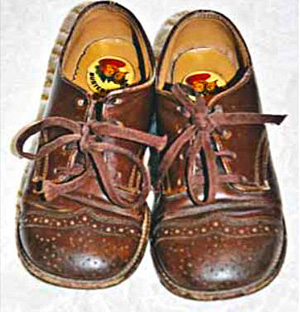 Millie's brown oxfords to wear with Girl Scout uniform were purchased at C.R. Dorrier's store. 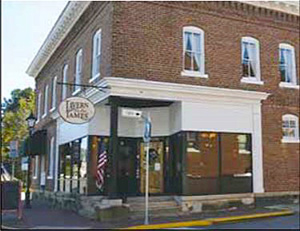 C.R. Dorrier's dry goods store. In 2018, the building is called The Tavern on the James. Near the end of April 1953, my father went to the hospital for the last time. He died on April 29, 1953, at the Martha Jefferson Hospital in Charlottesville. My mother was now a thirty-four-year-old widow with two children to raise alone. Employment opportunities for her in Scottsville did not look promising. My mother reluctantly decided to move to Charlottesville where more jobs were available. Her mother, a sister, and a brother lived there, another advantage. In August 1953, I turned eleven. Shortly after my birthday, a moving van was parked in front of our house. Eventually all of our possessions were stowed away. My last memory of that day is hearing the door of the moving van slammed shut. My Scottsville childhood was over. But the memories of those long-ago days are with me still. Copyright © 2020 by Scottsville Museum |
|
|
|
Museum
Archive
Business
Cemeteries
Church
Events
Floods
For Kids
Homes
Portraits
Postcards
School
Transportation
Civil War WWII Esmont Search Policy |
||||
|
Scottsville Museum · 290 Main Street · Scottsville, Virginia 24590 · 434-286-2247 www.avenue.org/smuseum · info@scottsvillemuseum.com Copyright © 2020 by Scottsville Museum | ||||